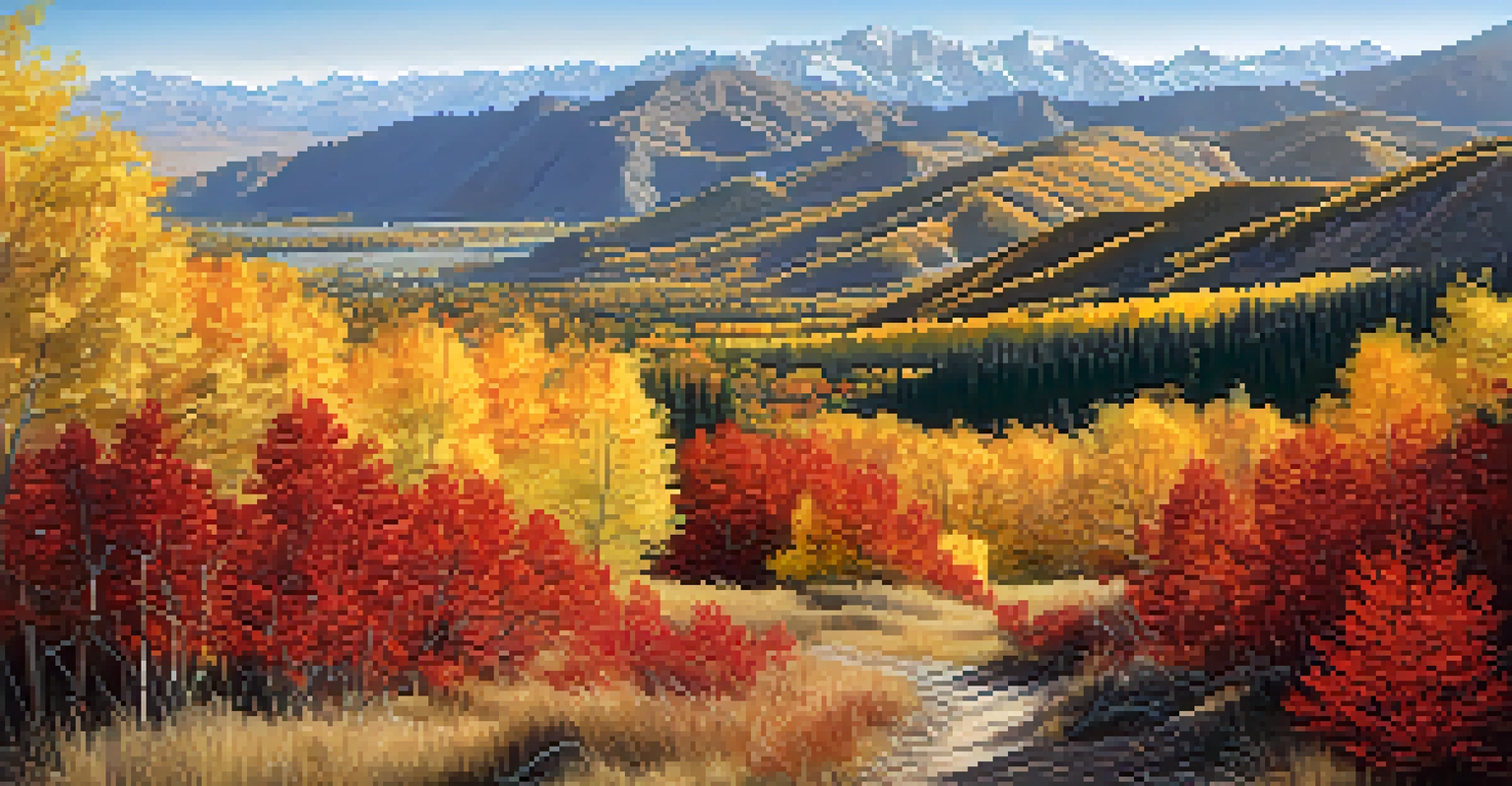Analyzing Utah's Temperature Variations Across Seasons

Overview of Utah's Seasonal Climate Patterns
Utah's climate is characterized by its distinct four seasons, each bringing unique temperature variations. Winters can be quite cold, while summers often feel hot and dry. This range of temperatures can significantly influence outdoor activities, agriculture, and even local wildlife. Understanding these seasonal changes helps residents and visitors alike prepare for what to expect throughout the year.
In every walk with nature one receives far more than he seeks.
In winter, temperatures can plummet, especially in the mountainous regions, making it a prime time for skiing and snowboarding. Conversely, the summer months can see temperatures soar, particularly in the southern parts of the state, where desert conditions prevail. The contrast in temperatures not only affects daily life but also shapes the very ecosystems present in Utah's diverse landscapes.
By analyzing these seasonal patterns, we can better appreciate Utah's unique climate and how it impacts everything from tourism to local flora and fauna. This insight also helps in planning agricultural activities, ensuring crops are planted and harvested at the right times.
Winter Temperatures: Cold and Snowy Adventures
Winter in Utah typically runs from December to February, bringing cold temperatures and significant snowfall, especially in the northern regions. Average temperatures can range from the low teens to mid-thirties in Fahrenheit, creating ideal conditions for winter sports enthusiasts. Ski resorts like Park City and Deer Valley become bustling hubs during this season, attracting tourists eager for snowy adventures.

The snowpack that builds up during winter is crucial for Utah's water supply, feeding rivers and reservoirs throughout the year. This seasonal snow not only supports recreational activities but also plays a vital role in the state's ecosystem. As temperatures begin to warm in late winter, the gradual melting of snow leads to beautiful spring runoff.
Utah's Climate: Four Distinct Seasons
Utah experiences four distinct seasons, each with unique temperature variations that influence outdoor activities, agriculture, and wildlife.
For those who embrace the chill, winter offers a magical landscape, from frosted trees to snow-capped mountains. It's a time that both locals and visitors can enjoy, whether through outdoor activities or simply appreciating the serene beauty of Utah's winter wonderland.
Spring: A Season of Renewal and Transition
Spring in Utah typically spans from March to May, heralding a welcome transition from the cold winter months. During this season, temperatures gradually rise, with averages ranging from the mid-forties to mid-seventies. This warming trend brings a sense of renewal as flowers bloom and wildlife becomes more active, painting the landscape with vibrant colors.
The mountains are calling and I must go.
One of the most striking features of spring in Utah is the rapid change in weather conditions. It's not uncommon for a sunny day to be followed by sudden rain or even snow, showcasing the unpredictable nature of the season. This variability can be both a challenge and a delight, particularly for those who enjoy outdoor activities like hiking and biking.
Spring also marks the beginning of the growing season for many crops in Utah's agricultural regions. Farmers prepare their fields, planting a variety of fruits and vegetables that thrive in the warmer temperatures. The interplay of warmth and moisture during this time is essential for a successful harvest later in the year.
Summer: Hot Days and Cool Nights
Summer in Utah stretches from June to August, characterized by hot days and cooler nights, particularly in desert areas. Average daytime temperatures can soar into the nineties, especially in southern Utah, while the northern regions enjoy slightly milder conditions. This heat invites residents and tourists to engage in various outdoor activities, from hiking in the mountains to exploring the state's national parks.
The nights, however, provide a pleasant reprieve from the daytime heat, often dropping to the sixties. This temperature shift allows for comfortable evening gatherings, stargazing, and enjoying the state's natural beauty. Summer evenings can be magical, with clear skies and a canopy of stars that draws people outdoors.
Impact of Temperature on Wildlife
Seasonal temperature changes significantly affect local wildlife, influencing behaviors such as migration and hibernation.
Despite the heat, summer is a crucial time for agriculture, with many crops flourishing under the bright sun. Farmers harvest an array of fruits and vegetables, from peaches to tomatoes, contributing to the state's economy and culinary scene. This vibrant season is a testament to the resilience of nature and the joy of outdoor life in Utah.
Autumn: A Colorful and Crisp Transition
Autumn in Utah, spanning September to November, is a season marked by stunning foliage and cooler temperatures. As the leaves change color, the state transforms into a vibrant tapestry of reds, oranges, and yellows, drawing visitors for scenic drives and hikes. Average temperatures during this time range from the mid-fifties to mid-seventies, making it a comfortable season for outdoor exploration.
The crisp air of autumn brings a refreshing change, signaling the approach of winter. This season is often associated with harvest festivals, where communities come together to celebrate the bounty of crops, particularly in rural areas. Apples, pumpkins, and other produce are at their peak, offering a taste of Utah's agricultural richness.
As the days shorten and temperatures begin to drop, Utahns prepare for the upcoming winter months. This transition phase is not only visually stunning but also serves as a reminder of the cyclical nature of the seasons. By embracing the beauty of autumn, residents can appreciate the unique experiences each season brings.
Impact of Temperature Variations on Local Wildlife
Utah's temperature variations across seasons significantly impact local wildlife, influencing their behavior and habitats. Animals have adapted to the seasonal changes, with some species hibernating during the harsh winters while others migrate to warmer areas. Understanding these adaptations helps us appreciate the delicate balance of Utah's ecosystems.
For example, many birds migrate south as temperatures drop, seeking warmer climates during winter months. In contrast, species like deer and elk develop thicker coats to survive the cold. As spring arrives, these animals shed their winter coats and become more active, often seen in meadows and valleys as they seek food after the long winter.
Climate Change Affects Temperature Patterns
Climate change is altering Utah's temperature patterns, leading to warmer winters and hotter summers that impact agriculture and ecosystems.
The changing temperatures also affect plant life, which in turn influences the entire food chain. As flowers bloom in spring and fruits ripen in summer, various animals rely on these resources for sustenance. This interconnectedness highlights the importance of preserving Utah's natural habitats to ensure the survival of its diverse wildlife.
The Role of Climate Change in Temperature Variations
Climate change has begun to alter Utah's temperature patterns, leading to noticeable variations across seasons. Warmer winters and hotter summers are becoming more common, which can impact agriculture, water resources, and natural ecosystems. As temperatures shift, understanding these changes becomes crucial for planning and resource management in the state.
For instance, increased temperatures may result in reduced snowpack, affecting water supply during the warmer months. This change can have significant implications for agriculture, as farmers depend on consistent water sources for irrigation. Additionally, the shift in temperature patterns can disrupt the natural cycles of local wildlife, impacting feeding and breeding behaviors.

Addressing the effects of climate change requires collaborative efforts from communities, governments, and organizations. By raising awareness and promoting sustainable practices, Utah can work towards mitigating the impacts of rising temperatures and preserving its unique climate for future generations.
Preparing for Utah's Temperature Variations
To fully enjoy Utah's diverse seasons, it's essential to prepare for the temperature variations that each brings. Dressing in layers is a practical approach, allowing individuals to adapt to changing conditions throughout the day. For instance, a sunny winter day may start off chilly, but as the sun rises, temperatures can increase, so having a light jacket handy is wise.
Planning outdoor activities should also take the seasonal temperatures into account. While summer offers ample opportunities for hiking and camping, it's essential to stay hydrated and take breaks during the hottest parts of the day. In contrast, winter activities like skiing require appropriate gear to ensure safety and comfort in cold conditions.
Ultimately, being prepared for Utah's temperature variations enhances the overall experience, whether you're a resident or a visitor. Embracing the unique qualities of each season allows everyone to appreciate the beauty and adventure that Utah has to offer throughout the year.